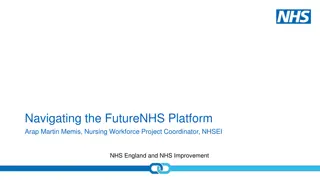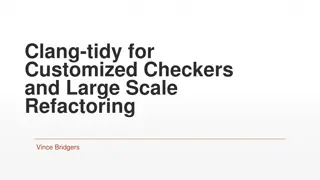Work by Balzs Szalkai, Vince K. Grolmusz, Vince I. Grolmusz, CAMD International Journal of Computer Applications
"The work by Balzs Szalkai, Vince K. Grolmusz, Vince I. Grolmusz, and the Coalition Against Major Diseases (CAMD) published in the International Journal of Computer Applications. This publication showcases their research and contributions to the field, providing valuable insights for the readers."
Download Presentation

Please find below an Image/Link to download the presentation.
The content on the website is provided AS IS for your information and personal use only. It may not be sold, licensed, or shared on other websites without obtaining consent from the author.If you encounter any issues during the download, it is possible that the publisher has removed the file from their server.
You are allowed to download the files provided on this website for personal or commercial use, subject to the condition that they are used lawfully. All files are the property of their respective owners.
The content on the website is provided AS IS for your information and personal use only. It may not be sold, licensed, or shared on other websites without obtaining consent from the author.
E N D
Presentation Transcript
Showcasing work by Bal zs Szalkai, Vince K. Grolmusz, Vince I. Grolmusz, Coalition Against Major Diseases (CAMD) International Journal of Computer Applications (0975 8887) Volume * - No. *, 2012 On Identifying combinatorial biomarkers by association rule mining in the CAMD Alzheimer's database
Reference [1] B. Szalkai, V. K. Grolmusz, V. I. Grolmusz, Coalition Against Major Diseases (CAMD), Identifying combinatorial biomarkers by association rule mining in the CAMD Alzheimer's database , Archives of Gerontology and Geriatrics, vol. 73, pp. 300-307, 2017 [2] B. Szalkai, V. Grolmusz, (2017, Sep). SCARF: A Biomedical Association Rule Finding Webserver, Available: https://arxiv.org/abs/1709.09850 [3] P.-N. Tan, M. Steinbach, V. Kumar, Association Analysis: Basic Concepts and Algorithms, in Introduction to Data Mining, Addison-Wesley 2005.
Introduction Identifying combinatorial biomarkers by association rule mining in the CAMD Alzheimer's database Alzheimer CAMD combinatorial biomarkers association rule mining - Dementia s common cause Alzheimer s disease (AD) - memory problems - difficulty: calculation, language, concentration - final stage: incapable of self-care, bedbound - Molecular biology Simple biomarkers - a physiological condition -> disease appearance e.g. high level of glucose -> diabetes Combinatorial biomarkers - high concentration of A, B and C -> condition X e.g. a 30-protein set -> AD Aim: Find combinatorial biomarkers -> AD &( or ) (*) Pattern: LHS RHS combinatorial marker of the RHS sodium=high & ( protein=high or age 60 ) MMSE* 15 *MMSE = Mini Mental Sate Examination
Scope and Objective Alzheimer s disease diagnostic cerebrospinal fluid analysis + clinical signs + neuroimaging techniques + reliable - expensive -not an early warning-type biomarker usual clinical laboratory + cognitive impairment questionnaires + blood-based proteomics assays + reliable - not an early warning-type biomarker Final Goal: Finding new combinatorial biomarkers for Alzheimer s disease In this paper: Showing certain sets of laboratory data may make dementia (and not AD) more probable, and certain other sets may make dementia less probable
Data Source:CAMD Instances: 5,821 patients (demented and not demented people of various age and sex) Attributes: Standard laboratory data blood and urine, measured multiple times per subject Cognitive and psychological status by standardized questionnaires ADAS-COG, ADCS-ADL, MMSE, NPI, SIB Genetic tests ApoE, MTHFR genotypes Data Cleaning Main table for CAMD 170 columns (record fields) 5,821 rows (patients) - Reduce several row for each person - Collect from multiple tables - Average tests on different visit days Vital sign measurement BP, pulse rate, respiratory rate, body temperature Target MMSE score (mini mental state examination)
Methods (1/2) Association rule mining: SCARF (Simple Combinatorial Association Rule Finder) - Own new program written in C++ - Various standard numerical values for indicating reliability and validity of rules : https://pitgroup.org/scarf/ : set of rows - all columns in the rule have a known value Universe LHS support : #rows - LHS is true RHS support : #rows - RHS is true Support : #rows - LHS and RHS are true Confidence : Lift : Leverage : X X2-statistic : dependence of LHS and RHS E-value : p-value * total number of pos. rules
Methods (2/2) Association rule mining: SCARF algorithm A & ( B or C) D (*) I. Start with pattern : - restriction: LHS - laboratory data and sex, RHS - mental status II. Consider all possible logical expressions according pattern (*) applied Branch-and-bound algorithm : certain values of first two boxes fail a rule constraints(regardless third box) -> threw out the rule w/o checking third box III. Evaluate rules under these criteria: universe 500, support 50, confidence 0.5, lift 1.2, p-value 0.05 Goodness of a rule IV. Determine effect on mental state by these definitions: Positive score : #rules with positive RHS Negative score : #rules with negative RHS Score : Positive score Negative score -> Positive clause -> Negative clause
Results and Discussion (1/3) Outputs 752 rules Lift 2 : 513 rules Most rules with Lift 3 : LHS contained lb_sodium = h sodium high total MMSE Score 15 Glucose low or normal Cholesterol Ex: &( or ) low Greatest Negative Effect on Normal Cognition Greatest Positive Effect on Normal Cognition
Results and Discussion (2/3) Liver function High AST + Low/high ALT -> Impaired Cognition (aspartate amino- transferase) transferase) (Low MMSE) (alanine amino- (mini mental state examination) Our results: Raise the possibility of a pathogenetic linkage between liver function and mental status in patients with AD Serum Sodium -> Impaired Cognition 224 rules with high Sodium in LHS Our results: demonstrated a tendency towards dehydration in patients with AD
Results and Discussion (3/3) Vitamin B12 Our results: present the beneficial impact of high vitamin B12 on cognition Hematological parameters Low MCV (mean corpuscular volume) High MCH (mean corpuscular hemoglobin) Low MCHC(mean corpuscular hemoglobin concentration) -> high MMSE Blood cholesterol and cognition Our results: low, low-normal or high cholesterol levels do not mean a higher likelihood of impaired cognition by themselves, but only combined with high sodium
Conclusions In this paper A 5,821-patient, high-quality database from CAMD was analyzed. Association rule mining (SCARF) was used. Combinatorial biomarkers related to Alzheimer's disease were found. 752 rules were identified.






















